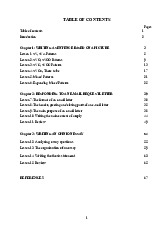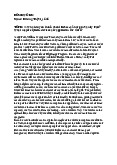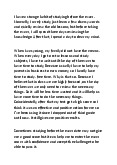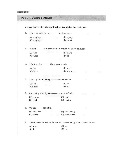



















Preview text:
BỘ GIÁO DỤC VÀ ĐÀO TẠO ĐẠI HỌC DUY TÂN KHOA TIẾNG ANH GIÁO TRÌNH WRITING LEVEL 2 Mã môn học: ENG 167
Chủ biên: Mai Lan Thi LƯU HÀNH NỘI BỘ Đà Nẵng, năm 2022 1 PREFACE
This course book “Writing level 2” aims to equip students with knowledge to train
their Writing skill and help them to do tests of TOEIC. Its content includes compound
sentences and adverbial clauses to write picture descriptions based on words given, language
for explaining a problem, making suggestions and requests, giving commands and soft
commands in writing a response e-mail, topic sentences, connectors between key ideas and outline of an opinion essay.
Chapter 1 includes 07 lessons, chapter 2 consists of 4 lessons, chapter 3 includes 5
lessons. This book gives students an opportunity to develop skills in writing. Many
exercises help students quickly improve writing skills through language material selected
from real tests. Each lesson has goals, which are clearly written, helping students obtain
what they need after a lesson. At the completion of this course, students will be able to
identify compound sentences, and adverbial clauses, topic sentences, connectors between key
ideas and outline of an opinion essay, analyze language for explaining a problem, making
suggestions and requests, giving commands and soft commands in writing a response e-mail,
write compound sentences, and adverbial clauses to describe pictures based on given words,
complete response e-mails using language for explaining a problem, making suggestions and
requests, giving commands and soft, develop topic sentences from thesis statements using
connectors between key ideas in an opinion essay and apply acquired knowledge and skills
in doing TOEIC writing test with the average score of 60-70 over 200 points. Although a
great effort has been made during the time researching and compiling this course book,
limitations, of course, are unavoidable. 2
TABLE OF CONTENTS (MỤC LỤC)
Chapter 1: WRITING A SENTENCE BASED ON A PICTURE
(COMPOUND & COMPLEX: CÂU GHÉP & CÂU PHỨC) 3 Lesson 1:
Compound sentences (with conjunctions) 4 Lesson 2:
Compound sentences (with conjunction adverb) 10 Lesson 3:
Adverbial clauses 1 (time, place) 17 Lesson 4:
Adverbial clauses 2 (manner, distance, frequency) 22 Lesson 5:
Adverbial clauses 3 (reason, result) 28 Lesson 6:
Adverbial clauses 4 (purpose, concession, contrast) 34 Lesson 7: Review test 39
Chapter 2: RESPONDING TO A WRITTEN REQUEST Lesson 8: Explaining a Problem 45 Lesson 9:
Making Suggestion and Requests 47 Lesson 10: Commands and Soft Commands 50 Lesson 11: Review 52
Chapter 3: WRITING AN OPINION ESSAY
Lesson 12: Developing the thesis statement 57
Lesson 13: Using connectors between key ideas 60
Lesson 14: Making outline from key ideas 68 Lesson 15: Review 71 3
CHAPTER 1: WRITING SENTENCES
Lesson 1: Compound sentences (with conjunctions)
Lesson 2: Compound sentences (with conjunction adverb)
Lesson 3: Adverbial clauses 1 (time, place)
Lesson 4: Adverbial clauses 2 (manner, distance, frequency)
Lesson 5: Adverbial clauses 3 (reason, result)
Lesson 6: Adverbial clauses 4 (purpose, concession, contrast) Lesson 7: Review test 4
LESSON 1: COMPOUND SENTENCES (WITH COORDINATOR) I-LANGUAGE FOCUS 1.1. Structure
A compound sentence is/has
two or more independent clauses joined together. A
compound sentence can be formed as follows:
Independent clause 1, + coordinator + independent clause 2 (S1+ V1 +…) (S2+ V2 +…)
Independent clause: SV, SVA, SVC, SVO, SVOO, SVOC, SVOA, SVCA…. 1.2.
Coordinator: liên từ kết hợp: + S +V…
There are seven coordinators, which are also called coordinating conjunctions. You
can remember them by the phrase FAN BOYS (For, And, Nor, But, Or, Yet, So). The
following sentences illustrate the meanings of the seven FAN BOYS coordinators.
Table 1.1. coordinating conjunctions To add a reason For: bởi vì
Japanese people live longer than most other nationalities, for they eat healthful diets.
To add a similar, equal idea And: và
They eat a lot of fish and vegetables, and they eat lightly .
To add a negative equal idea Nor: cũng
They do not eat a lot of red meat, nor do they eat many dairy products. không
Note: Nor means “and not.” It joins two negative independent clauses. Notice
that question word order is used after nor. To add an opposite idea But: nhưng
Diet is one factor in how long people live, but it is not the only factor.
To add an alternative possibility
Or: nếu không However, people should limit the amount of animal fat in their diets, or they risk thì, hoặc getting heart disease.
To add an unexpected or surprising continuation Yet: tuy nhiên
Cigarette smoking is a factor in longevity, yet Japanese and other long-lived
Asians have a very high rate of tobacco use.
To add an expected result 5 So: vì vậy
Doctors say that stress is another longevity factor, so try to avoid stress if you wish to live a longer life.
For 5 days (For: adv: khoảng)
For sb/st (For: preposition: cho ai/cái gì)
Note: - There is a comma after the first independent clause.
- But and yet have similar meanings: They both signal that an opposite idea is coming.
But is preferred when the two clauses are direct opposites. When the second clause is an
unexpected or surprising continuation because of information given in the first clause,
yet is preferred. (But is acceptable for both meanings; yet for only one meaning.) Compare:
I want to study art, but my parents want me to study engineering, (direct opposite)
I am very bad at math, yet my parents want me to study engineering, (surprising
continuation after “I am very bad at math”) II-LANGUAGE PRACTICE Use correct coordinator
1.Jaewon was cold, _______ he put on a coat.
2. Maria tried to read a novel in French, _______ it was too difficult.
3. To get from Vancouver to Victoria, you can fly, _______ you can ride the ferry.
4. I bought a bottle of wine, _______ we drank it together.
5. The waiter was not very nice, _______ the food was delicious.
6. I went to buy a Rolling Stones CD, _______ the shop didn't have it.
7. Anna needed some money,_______ she took a part-time job.
8. There's so much rain lately! Maybe it's because of El Nino, _______ maybe it's just coincidence.
9. Julie has a guitar, _______ she plays it really well.
10. The concert was cancelled, _______ we went to a nightclub instead. 6 III-PRACTICE IN TOEIC 3.1. Building Language
a- Give nouns, verbs or coordinators which may be used to describe pictures 1-6.
Compare with your friends.
b- Complete the following pictures 1-6 with the given words: so and stops so
talking listening hung and sold
1. The bus…………………., for the
3. The clothes are ………on the street, girl wants to get off.
and a woman is choosing an item.
2. The merchant uses ice, ……….he can keep the fish fresh.
4. An agreement has been reached,
……….they are shaking hands. 7
5. The man is listening to the information,
…............... he is taking notes.
6. The businessman is ………....to the
woman, and she is ……………..carefully to what he is saying. 3.2. Tactic Practice
3.2.1. Put the words in the correct order
2. got/ the girl/ medals/ for/ the/
gold/ she/ won/ races/ three/ all.
1. stopped/ got/ girl/ off / school bus/ the/ the/ and
3. kinds/ many/ of clothes/ are/and /on
for sale/ them/ there are/ labels. 8
5. come to/ the teacher/ talk/ wants to/ students/ so/ they/ class.
4. listening to/ is/ the woman/ the man/ and/ explaining/ her/ is.
6. writing/ down/the information/ the
man/can’t/ or/ he/ is/ it / remember
3.2.2. Make sentences about the pictures with the suggested words 1. happy/ for/ party 2. expensive / but / buy
…………………………………
……………………………………
….………………………………… ……
………………………………… 6. over/ and/ home …… 9
…………………………………
…………………………………… ……
….…………………………………
………………………………… 3. rainy/ so/ stay …… 4. nice/ park/ so
………………………………… ……
………………………………… ……
……………………………………
….………………………………… 4. eat/ use/ and 3. Test Practice
In this part of the test, you will write ONE sentence that is based on a picture. With
each picture, you will be given two words or phrases that you must use in your sentence.
You can change the forms of the words and you can use the words in any order. 1. birthday/ so 4. sandcastle/ and 10
…………………………………………
………………………………………….
…………………………………………
…………………………………………. 2. famous/ come / so 5. outside/ for/ phone
…………………………………………
……………………………………………
…………………………………………
…………………………………………… 3. dirty/ wash / and 6. hold/ write/ and
………………………………………
LESSON 2: COMPOUND SENTENCES
(WITH CONJUNCTIVE ADVERBS) I-LANGUAGE FOCUS 1.1. Structure
A second way to form a compound sentence is as follows: 11
Independent clause; + conjunctive adverb, + independent clause
Ex: Salt water boils at a higher temperature than freshwater; therefore, food cooks faster in salt water.
1.2. Conjunctive adverbs
Table 1.2. Conjunctive adverbs
To add a similar, equal idea also
Community colleges offer preparation for many occupations; besides
also/besides/furthermore/ in addition/moreover, they prepare furthermore
students to transfer to a four-year college or university. in addition moreover: ngoài ra, bên cạnh đó
To add an unexpected or surprising continuation However;
The cost of attending a community college is low; nevertheless
however/nevertheless/nonetheless/still, many students need financial nonetheless; aid. still: tuy nhiên
To add a complete contrast on the other hand
Tuition at a community college is low; on the other hand/in contrast, in contrast:
tuition at private schools is high. trái lại
To give an alternative possibility Otherwise
Students must take final exams; otherwise, they will receive a grade of incomplete.
To add an expected result accordingly
Native and nonnative English speakers have different needs; as a result
accordingly/as a result/ consequently/hence/therefore/thus, most consequently
schools provide separate English classes for each group. hence; therefore thus To add an example 12 for example
Most colleges now have a writing requirement for graduation; for for instance
example/for instance, students at my college must pass a writing test
before they register for their final semester.
Note: Put a semicolon before and a comma after the conjunctive adverb.
Several transition signals, such as on the other hand, as a result, and for example, act like
conjunctive adverbs; they can also connect independent clauses with a semicolon and a comma. II-LANGUAGE PRACTICE
Choose the correct conjunctive adverbs
1. The work was new to me………. , it did not seem difficult. (Consequently, Nevertheless)
2. He is old…………. , his mind is still active. (Nonetheless, Therefore)
3. It was very misty. ……….., we could not get a clear view of the mountain. (Hence, However)
4. We had walked several miles……….. , we did not feel tired. (Accordingly, Still)
5. She is a talented actress…………. , she is very beautiful. (Moreover, Thus)
6. We take the bus every day………. , we are familiar with the bus route. (Nevertheless, Thus)
7. The child was sleepy………… , we went home early. (Otherwise, Therefore)
8. The food was delicious………… , the service was excellent. (Likewise, Nevertheless)
9. We looked everywhere. ………, we could not find the keys. (However, Thus)
10. The book is long…………… , the vocabulary is difficult. (Consequently, Furthermore) III-PRACTICE IN TOEIC 3.1. Building Language
a- Give some nouns, verbs, conjunctive adverbs which may be used to describe
pictures 1-6. Compare with your friends.
b- Complete the following about pictures 1-6 with the given words:
therefore however meeting suitcase empty got out of
1. The restaurant is open; however, it
2. There is a conference; ………….;
is .....................................
13there are many cars in front of the building. 5.
3. The tables are set up;…………, there
The man is walking; besides, he is is no one in the restaurant. holding a ……………….
4. The man wanted some fresh air;
6. They are in the ………….; therefore, therefore, they are wearing formal suits. he …………..…the car. 3.2. Tactic Practice
3.2.1. Put the words in the right order.
1. foggy/ however/ many/ it/ was/ cars/
there/ were/ on the street/ this morning. 14
4. are/ sale/ the goods/ on/ hence/
customers/ are/ the shop/ in/ there/ many.
2. The autumn/ coming/ as a result/
yellow leaves/ falling/ is/ down/ are.
5. explain/ trying to/ the woman/ is/
nevertheless/ understands/ no one/ her.
3. many/ tools/ it/ has/ workshop/ small/ the/ however/ is.
6. focusing on/ the exam/ the students/
otherwise/ on time/ can’t/ finish/ are/ they 15
3.2.2.Make sentences about the pictures with the words
1. storm/ therefore/ damage
2. vegetables/ in addition/ price
…………………………………………. ………………………………………….
…………………………………………. ………………………………………….
3. close/ therefore/ late
5. break/ fix/ as a result
…………………………………………. ………………………………………….
…………………………………………. …………………………………………. 4. exercise/ / help 6. hold/ ride/ also
……………………………………
……………………………………
………………………………………
………………………………………
……………………………………
…………………………………… 16 3.3. Test Practice
In this part of the test, you will write ONE sentence that is based on a picture.
With each picture, you will be given two words or phrases that you must use in your
sentence. You can change the forms of the words and you can use the words in any order. 1. winter/ trees/ hence
2. excited/ thus/ agreement
…………………………………………
…………………………………………
…………………………………………
…………………………………………
3. work/ therefore/ stressed 4. cold/walk/ however
…………………………………………
…………………………………………
…………………………………………
………………………………………… 5. taxi/ however/ stop
6. outside/ weather/ therefore 17
………………………………………………. .
………………………………………………. .
…………………………………………..
…………………………………………..
LESSON 3: ABVERBIAL CLAUSES 1 (TIME, PLACE) I-LANGUAGE FOCUS 1.1. Time clause:
A time clause is introduced by one of the subordinators in the following chart. A
time clause can come before or after an independent clause.
Table 1.3. Time Subordinators Time Subordinators when: a specific
When people had to hunt for food, they moved time from place to place. whenever: at any
Whenever food became scarce in one area, they time moved to another area. while: at the same
The men hunted game while the women time gathered plants. as soon as: soon
Eating habits changed as soon as people stopped after
moving from place to place in search of food. after: later
After people learned how to grow their own
food, they settled in villages. since: from that
Since the United States changed from an time
agricultural to an industrial society, eating habits there have changed.
as: at the same time People in the United States started eating more
processed convenience foods as their lives became busier. 18 before: earlier
Before people in the United States moved to
cities, they grew most of their own food. until: up to the
Women had time to cook meals “from time
scratch”1until they went to work in factories d ffi 1.2. Place clause:
An adverb place clause tells where the action described by the main verb took place. The
subordinators wherever, everywhere, and anywhere are similar in meaning and are
interchangeable. You can begin a sentence with wherever, everywhere, and anywhere
clauses, but usually not with a where clause. (Expressions such as the following are
exceptions: Where there is lightning, there is thunder. Where there is smoke, there is fire.)
Table 1.4. Place Subordinators Place Subordinators where: a specific place
Most people shop where they get the l t i wherever: any place
1 pay by credit card wherever 1 can. everywhere: every place
Can you use an ATM card everywhere you shop? anywhere: any place
Anywhere you go, you hear people talking on their cell phones. II-LANGUAGE PRACTICE Fill in the gaps
1. Travelers can use credit cards in foreign countries__________they are accepted.
2. Tonight I will go to bed after I _________________________my homework.
3. Ever since I was a child, I ____________________________________ afraid of dogs.
4. Jacquie's contact lens popped out while she _____________________basket ball.
5. Be sure to reread your composition for errors before you _________________ it in to the teacher tomorrow. III-PRACTICE IN TOEIC 3.1. Building Language
- Give some words which may be used to describe pictures 1-6. Compare with your friends.
- Complete the following about pictures 1-6 with the given words: while while as soon as came before until 1 19
1. The restaurant employees have to wait
…………customers start arriving.
4. The employees are looking at the
man………….he is explaining something.
5. The man is speaking on the phone
2. ………the show starts, the lights are
…………….he is standing in front of a turned on. refinery.
6. The teacher wants to talk to
3. Before they ……………, it rained
students ………….they come to class. heavily. 3.2. Tactic Practice
3.2.1. Put the words in the correct order 20




